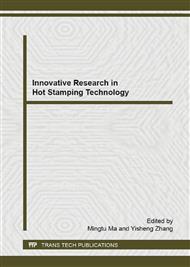[1]
Zhong-xiang Gui, Wei-kang Liang, Yong Liu, Yi-sheng Zhang,Thermo-mechanical behavior of the Al–Si alloy coated hot stamping boron steel Original Research Article,Materials & Design, Volume 60 (2014), pp.26-33.
DOI: 10.1016/j.matdes.2014.03.011
Google Scholar
[2]
Peixing Liu, Yisheng Zhang,etc., Modeling for periodic striation and microstructure evolution in active gas melt laser cutting for phase hardened parts,The International Journal of Advanced Manufacturing Technology,Volume 70, Issue 5-8(2014).
DOI: 10.1007/s00170-013-5385-z
Google Scholar
[3]
Xiaoyu Luo, Zijian Wang, Yu Zhang, Yisheng Zhang, Non-Destructive Testing Device for Hot Forming High Strength Steel Parts Based on Barkhausen Noise, Applied Mechanics and Materials Vols. 423-426 (2013) pp.2555-2558.
DOI: 10.4028/www.scientific.net/amm.423-426.2555
Google Scholar
[4]
Xiaoyu Luo, Liang Wang, Yisheng Zhang, Nonlinear numerical model with contact for Stockbridge vibration damper and experimental validation, Journal of Vibration and Control, first published on May 19, 2014 doi: 10. 1177/1077546314535647.
DOI: 10.1177/1077546314535647
Google Scholar
[5]
E. S. Gorkunov, A. M. Povolotskaya, V. G. Kuleev, V. K. Chistyakov, and O. B. Korobka, Coercive force of a package of steel sheets with different degrees of magnetic hardness, Russian Journal Of Nondestructive Testing, vol. 38(2002), pp.331-338.
DOI: 10.1023/a:1020960918166
Google Scholar
[6]
D. C. Jiles, Dynamics of domain magnetization and the Barkhausen effect, Czechoslovak Journal of Physics, vol. 50(2000), pp.893-924.
Google Scholar
[7]
.A. I. Ul'anov, A. A. Chulkina, and E. S. Gorkunov, The effect of tempering temperature on the coercive force of high-carbon steels measured at room temperature and a temperature above the curie point of cementite, Russian Journal Of Nondestructive Testing, vol. 46(2010).
DOI: 10.1134/s1061830910090019
Google Scholar
[8]
M. Blaow, J. T. Evans, and B. A. Shaw, Surface decarburisation of steel detected by magnetic Barkhausen emission, Journal of Materials Science, vol. 40(2005), pp.5517-5520.
DOI: 10.1007/s10853-005-4240-5
Google Scholar
[9]
V. Moorthy, B. A. Shaw, and J. T. Evans, Evaluation of tempering induced changes in the hardness profile of case-carburised EN36 steel using magnetic Barkhausen noise analysis, Ndt & E International, vol. 36(2003), pp.43-49.
DOI: 10.1016/s0963-8695(02)00070-1
Google Scholar


